Table of Contents
<!-- Template Revision 1.6 (HTML comments will be not displayed in the document, no need to remove them. For Template/Skeleton changes, increase Template Revision number. So we can check faster, if the TRM style is up to date). --> |
Table of Contents |
Trenz Electronic TE0741 is an industrial-grade FPGA module integrating a Xilinx Kintex-7 FPGA, 32 MByte SPI Flash memory for configuration and operation, and powerful switching-mode power supplies for all on-board voltages. A large number of configurable I/Os is provided via rugged high-speed stacking strips.
The TE0741 module is available in four different logic densities (70T, 160T, 325T and 410T). The 70T and 160T devices can be programmed with the free Xilinx Vivado WebPACK software. Further information about the Kintex-7 FPGA can be found in the Xilinx document 7 Series FPGA's Overview (DS180).
Refer to http://trenz.org/te0741-info for online version of this manual and the rest of available documentation. |
Additional assembly options are available for cost or performance optimization upon request.
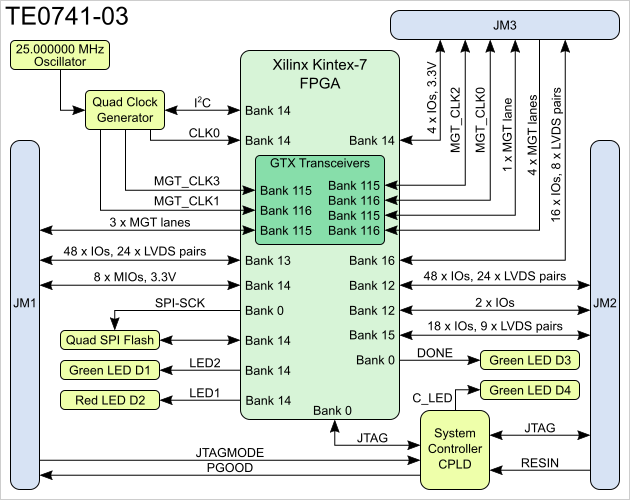
Figure 1: TE0741 block diagram.
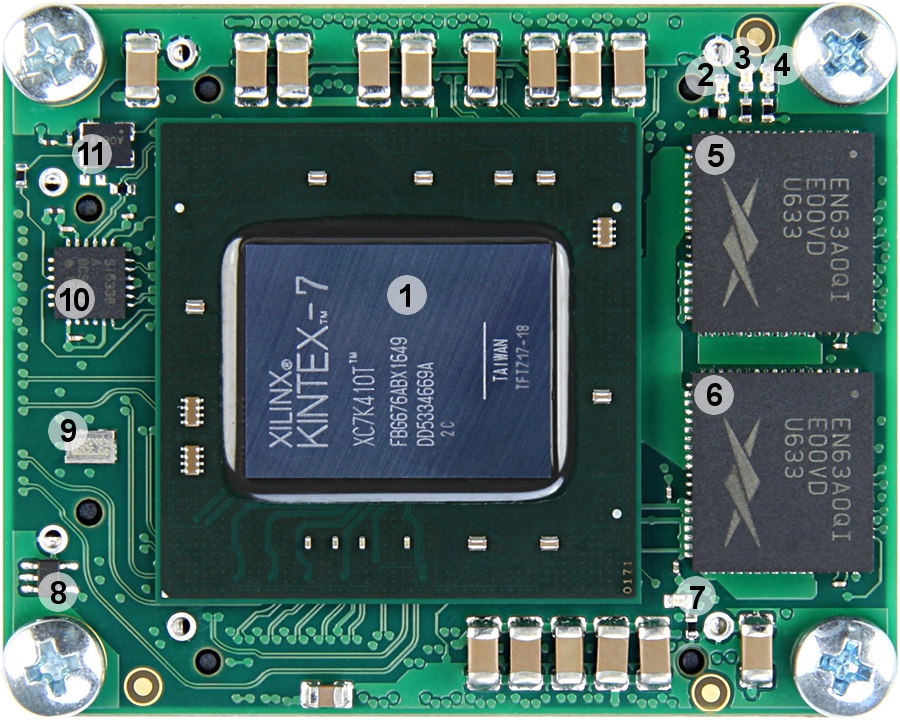
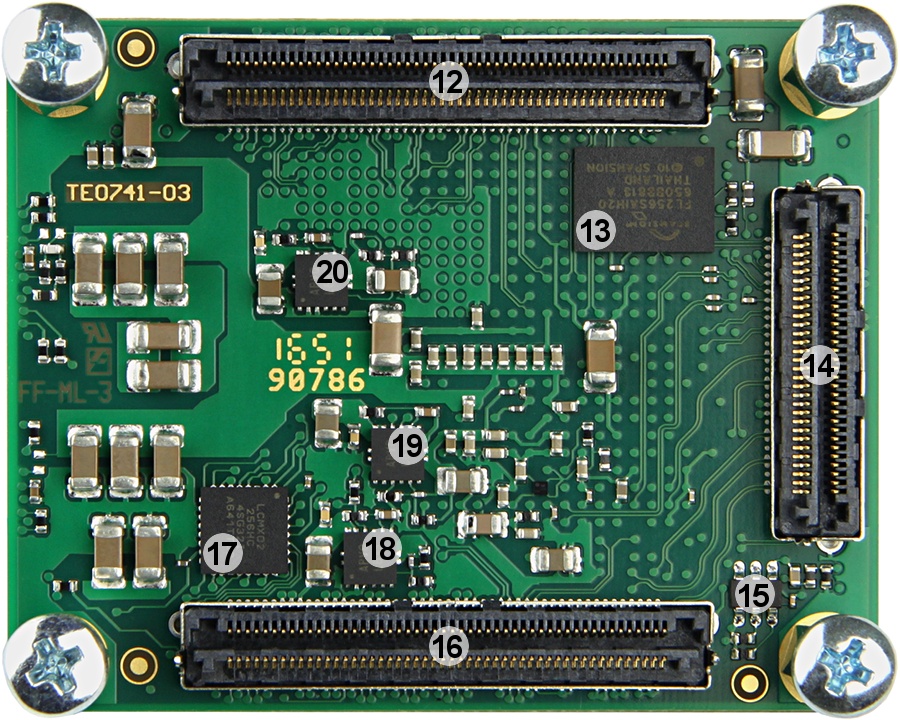
Figure 2.1: TE0741--03-410-2CF module.

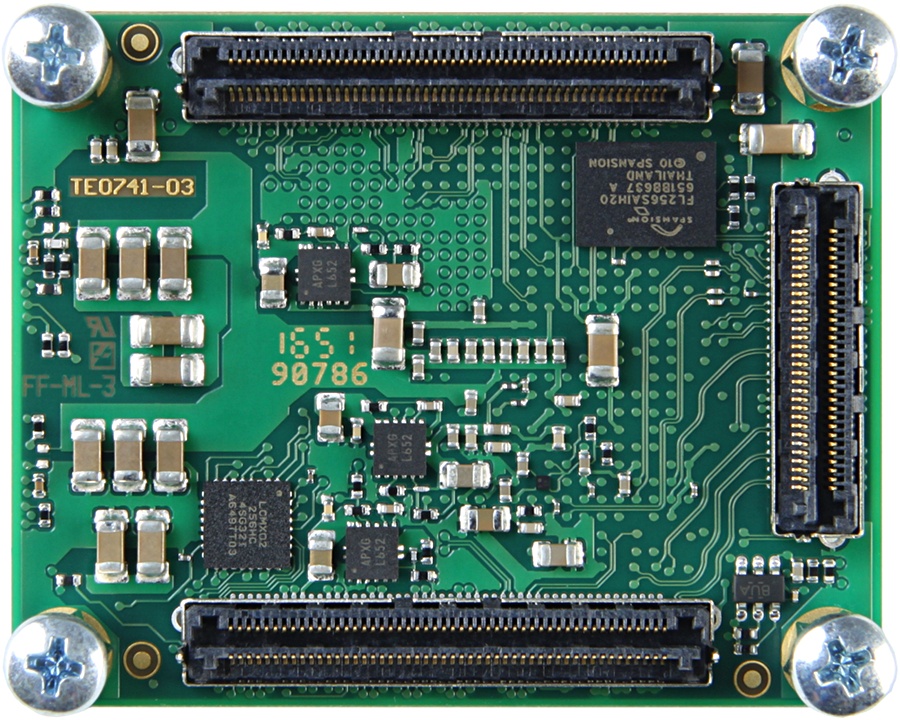
Figure 2.2: TE0741-03-160-2C1 module.
Voltage detector, U11
| Storage device name | Content | Notes |
|---|---|---|
SPI Flash OTP Area | Empty, not programmed | Except serial number programmed by flash vendor. |
SPI Flash Quad Enable bit | Programmed | - |
SPI Flash main array | Demo design | - |
eFUSE USER | Not programmed | - |
eFUSE Security | Not programmed | - |
Table 1: Initial delivery state.
Overview of the I/O signal banks connected to the B2B connectors:
| Bank | Type | B2B Connector | I/O Signal Count | Voltage | Notes |
|---|---|---|---|---|---|
0 | HR | - | - | 3.3V | Configuration bank. |
12 | HR | JM2 | 50 I/Os, 24 LVDS pairs | User | Supported voltage level from 1.2V to 3.3V. NOTE: BANK 12 IS NOT AVAILABLE ON THE K70T DEVICE! |
13 | HR | JM1 | 48 I/Os, 24 LVDS pairs | User | Supported voltage level from 1.2V to 3.3V. |
14 | HR | JM1 JM3 | 8 I/Os 4 I/Os, 2 LVDS pairs | 3.3V | IO pins at B2B connector JM1, support only 3.3V. |
15 | HR | JM2 | 18 I/Os, 9 LVDS pairs | User | Supported voltage level from 1.2V to 3.3V. |
16 | HR | JM3 | 16 I/Os, 8 LVDS pairs | User | Supported voltage level from 1.2V to 3.3V. |
32 | HP | NC | - | - | Bank not used. |
33 | HP | NC | - | - | Bank not used. |
| 34 | HP | NC | - | - | Bank not used. |
Table 2: Available I/O signal banks connected to the B2B connectors.
Please use Master Pin-out Table table as primary reference for the pin mapping information.
JTAG access to the Xilinx Kintex-7 and to the System Controller CPLD is provided through B2B connector JM2.
| JTAG Signal | B2B Connector |
|---|---|
| TMS | JM2-93 |
| TDI | JM2-95 |
| TDO | JM2-97 |
| TCK | JM2-99 |
Table 3: Pin-mapping of JTAG Interface on B2B connector.
| JTAGMODE pin 89 in B2B connector JM1 is used to select which device is accessible, low - Xilinx Kintex-7, high - System Controller CPLD. |
Special purpose pins are connected to smaller System Controller CPLD and have following default configuration:
| Pin Name | Mode | Function | Default Configuration | B2B Connector |
|---|---|---|---|---|
| PGOOD | INOUT | Power Good | Active low when all on-module power supplies failed, otherwise high impedance | JM1-30 |
| RESIN | Input | Reset | Active low reset signal, drive low to keep the system in reset (FPGA pin PROG_B will be driven by CPLD). | JM2-18 |
| JTAGMODE | Input | JTAG Select | Low for normal operation, high (3.3V) to program the System Controller CPLD. | JM1-89 |
Table 4: Pin-description of System Controller CPLD. Important, functionality depends on CPLD Firmware, see TE0741 CPLD. General 4x5 module controller IO description on 4 x 5 SoM Integration Guide#4x5SoMIntegrationGuide-4x5ModuleControllerIOs
There are four LED's available on TE0741 SoM. Two status LED's (D3 and D4) and two user configurable LED's (D1 and D2).
| LED | Color | Connected to | Description and Notes |
|---|---|---|---|
| D1 | Green | LED2 | User configurable LED. |
| D2 | Red | LED1 | User configurable LED. |
| D3 | Green | DONE | Reflects inverted DONE signal, ON when FPGA is not configured, OFF as soon as PL is configured. This LED will not operate if the the 3.3V power rail is not available. After FPGA configuration the user can use USRACCESSE2 to control Done LED. |
| D4 | Green | C_LED | Connected to the system controller indicating status of the module, functionalitly, see: TE0741 CPLD#LED |
Table 5: Description of the on board LED's.
Note: if FPGA logic toggles DONE pin (to control D3) then D4 will toggle at random, as changing value on DONE will change the blink frequency of D4.
DONE LED will be ON as long as FPGA is NOT configured and will be OFF when FPGA is configured successfully. If user STARTUPE2 primitive is used in user design then DONE LED is controlled by the user design and can be on/off/blink or have any other functionality defined by the user. |
To enable the PLL (phase-locked loop) clock generator Si5338A (U2), CLK_EN-signal (bank 14, pin C26) must be set to high, to activate the 25 MHz reference clock SiT8208AI (U3). The GTX reference clocks 0 and 2 have to be provided by the user on B2B connector JM3.
| Clock | Frequency | IC | FPGA | Notes |
|---|---|---|---|---|
PLL reference | 25 MHz | U3 SiT8208AI | - | Activated by CLK_EN pin of FPGA. |
GTX REFCLK0 | - | B2B | D5/D6 | B2B connector pins: MGT_CLK_0_N: JM3-31 MGT_CLK_0_P: JM3-33 Needs decoupling and differential terminator on base board. |
| GTX REFCLK1 | 125 MHz | U2 Si5338 | F5/F6 | PLL clock 1, default frequency is 125 MHz. |
| GTX REFCLK2 | - | B2B | H5/H6 | B2B connector pins: MGT_CLK_2_N: JM3-32 MGT_CLK_2_P: JM3-34 Needs decoupling and differential terminator on base board. |
| GTX REFCLK3 | 125 MHz | U2 Si5338 | K5/K6 | PLL clock 2, default not configured |
| Bank 14 input clock | 100 MHz | U2 Si5338 | F22/E23 | PLL clock 0, default frequency is 100 MHz. |
Table 6: Clocks overview.
There is a Silicon Labs I2C programmable clock generator Si5338A (U2) chip on the module. It's output frequencies can be programmed using the I2C bus address 0x70 or 0x71 (PLL_IN4 (LSB of I2C-Address) must be set for address 0x71).
A 25 MHz oscillator is connected to pin IN3 and is used to generate the output clocks. The oscillator has its enable pin connected to an FPGA pin (CLK_EN). Driving the FPGA pin low will disable the oscillator output, setting it high will enable it. Three of the Si5338 clock outputs are connected to the FPGA. One is connected to a logic bank and the other two are connected to the GTX banks. It is possible to use the clocks connected to the GTX bank in the user's logic design. This is achieved by instantiating a IBUFDSGTE buffer in the design.
The default frequency of each clock at start up is detailed in the table 7.
Once running, the frequency and other parameters can be changed by programming the device using the I2C bus connected between the FPGA (master) and clock generator (slave). Logic needs to be generated inside the FPGA to utilize I2C bus correctly.
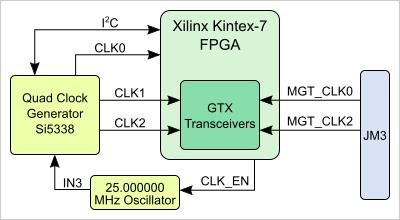
Figure 3: Clocking block diagram.
| I/O Si5338A (U2) | Default Frequency | Notes |
|---|---|---|
IN1/IN2 | - | Not used (external clock signal supply). |
IN3 | 25MHz | Fixed input clock signal from. reference clock generator SiT8208AI (U3). |
IN4 | - | LSB of the default I2C-Adress 0x70. |
IN5/IN6 | - | Not used (external clock signal supply). |
CLK0 A/B | 100 MHz | Bank 14 clock input, Pins: B14_L12_P, B14_L12_N |
CLK1 A/B | 125MHz | MGT reference clock 1 to FPGA Bank 116 MGT |
CLK2 A/B | - | MGT reference clock 3 to FPGA Bank 115 MGT |
| CLK3 | - | not used |
Table 7: Pin description of Si5338A PLL clock generator.
An SPI flash memory S25FL256SAGBHI20 (U4) is provided for FPGA configuration file storage. After configuration completes the remaining free memory can be used for application data storage. All four SPI data lines are connected to the FPGA allowing x1, x2 or x4 data bus widths to be used. The maximum data transfer rate depends on the bus width and clock frequency.
SPI Flash QE (Quad Enable) bit must be set, or the FPGA would not configure itself from Flash. This bit is always set at the manufacturing. |
The Kintex-7 device that is used on the TE0741 board has 8 GTX transceivers. All 8 are wired directly to connectors JM1 and JM3. There are also 4 clocks that are associated with the transceivers. Two of the clocks are connected directly to JM3, whilst the other two are derived from the clock generator. As there is no capacitive coupling of the data and clock lines that are connected to the connectors, these may be required on the user’s PCB depending on the application.
To enable the voltage supply for the GTX transceivers, namely the Enpirion EP53F8QI voltage regulators U6 and U16, which serve the voltages MGTAVCC (1.0 V) and MGTAVTT (1.2 V), the signal EN_MGT (bank 14, pin H22) have to be set high. The voltage regulators will indicate "Power OK" with signals PG_MGT_1V and PG_MGT_1V2, when reaching stable state.
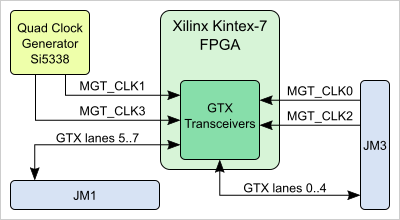
Figure 4: GTX transceiver block diagram.
The System Controller CPLD is used to coordinate the configuration of the FPGA. The FPGA is held in reset (by driving the PROG_B signal) until the power supplies have sequenced. Setting input signal RESIN low will also reset the FPGA. This signal can be driven from the user’s PCB via the board connector.
User can create its own System Controller CPLD design using the Lattice Diamond software and program it into the device using the JTAG interface. The JTAGMODE signal should be set to 3.3V to enable programming mode, for normal module operation it should be set to 0V.
Green LED D4 (C_LED) connected to the System Controller CPLD is to indicate the status of the module. CPLD Firmware, see TE0741 CPLD.
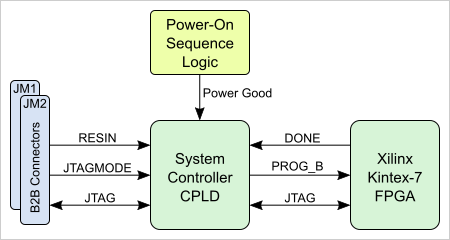
Figure 5: System Controller CPLD block diagram.
Power supply with minimum current capability of 3A for system startup is recommended.
Power Consumption
| Power Input Pin | Typical Current |
|---|---|
| VIN | TBD* |
| 3.3VIN | TBD* |
Table 8: Maximum current of power supplies.
* TBD - To Be Determined.
Lowest power consumption is achieved when powering the module from single 3.3V supply. When using split 3.3V/5V power supplies, the power consumption (and heat dissipation) will rise, this is due to the DC-DC converter efficiency (it decreases when VIN/VOUT ratio rises).
For highest efficiency of on board DC-DC regulators, it is recommended to use same 3.3V power source for both VIN and 3.3VIN power rails. Although VIN and 3.3VIN can be powered up in any order, it is recommended to power them up simultaneously.
It is important that all baseboard I/Os are 3-stated at power-on until System Controller sets PGOOD signal high (B2B connector JM1, pin 30), or 3.3V is present on B2B connector JM2 pins 10,12 or 91, meaning that all on-module voltages have become stable and module is properly powered up.
See Xilinx datasheet DS182 for additional information. User should also check related baseboard documentation when choosing baseboard design for TE0741 module.
The FPGA 1.0V supply is derived from two regulators operating in a parallel allowing higher load currents. To start the power-on sequence, pin EN1 (JM1-28, enable 1.0V voltage regulators) is by default high. By driving EN1 pin low on base-board the power-on sequence will not start until the EN1 pin is released to high.
Voltages on B2B-Connectors | B2B JM1 Pin | B2B JM2 Pin | B2B Direction | Note |
|---|---|---|---|---|
| VIN | 1, 3, 5 | 2, 4, 6, 8 | Input | Supply voltage. |
| 3.3VIN | 13, 15 | - | Input | Supply voltage. |
| VCCIO12 | - | 7, 9 | Input | High range bank voltage. |
| VCCIO13 | 9, 11 | - | Input | High range bank voltage. |
| VCCIO15 | - | 5 | Input | High range bank voltage. |
| VCCIO16 | - | 1, 3 | Input | High range bank voltage. |
| 3.3V | - | 10, 12, 91 | Output | Internal 3.3V voltage level. |
Table 9: Power rails of SoM on B2B connectors.
| Bank | Schematic Name | Voltage | Range |
|---|---|---|---|
| 0 Config | 3.3V | 3.3V | - |
| 12 | VCCIO12 | user | HR: 1.2V to 3.3V |
| 13 | VCCIO13 | user | HR: 1.2V to 3.3V |
| 14 | 3.3V | 3.3V | - |
| 15 | VCCIO15 | user | HR: 1.2V to 3.3V |
| 16 | VCCIO16 | user | HR: 1.2V to 3.3V |
Table 10: Range of FPGAs bank voltages.
See Xilinx Kintex-7 datasheet DS182 for the voltage ranges allowed.
Module Variant | FPGA | U15 | FPGA Junction Temperature | Temperature Grade |
|---|---|---|---|---|
| TE0741-03-070-2CF | XC7K70T-2FBG676C | - | 0°C to 85°C | Commercial grade |
| TE0741-03-070-2IF | XC7K70T-2FBG676I | - | -40°C to 100°C | Industrial grade |
| TE0741-03-160-2CF | XC7K160T-2FBG676C | - | 0°C to 85°C | Commercial grade |
| TE0741-03-160-2C1 | XC7K160T-2FFG676C | - | 0°C to 85°C | Commercial grade |
| TE0741-03-160-2IF | XC7K160T-2FBG676I | - | -40°C to 100°C | Industrial grade |
| TE0741-03-325-2CF | XC7K325T-2FBG676C | EN63A0QI | 0°C to 85°C | Commercial grade |
| TE0741-03-325-2IF | XC7K325T-2FBG676I | EN63A0QI | -40°C to 100°C | Industrial grade |
| TE0741-03-410-2CF | XC7K325T-2FBG676C | EN63A0QI | 0°C to 85°C | Commercial grade |
Table 11: Module TE0741-03 variants.
| Parameter | Min | Max | Units | Notes |
|---|---|---|---|---|
VIN supply voltage | -0.3 | 6.5 | V | - |
| 3.3VIN supply voltage | -0.1 | 3.6 | V | - |
| PL IO bank supply voltage for HR I/O banks (VCCO) | -0.5 | 3.6 | V | - |
| I/O input voltage for HR I/O banks | -0.4 | VCCO_X+0.55 | V | - |
| GT receiver (RXP/RXN) and transmitter (TXP/TXN) | -0.5 | 1.26 | V | Xilinx datasheet DS182 |
| Voltage on module JTAG pins | -0.5 | VCCO_0+0.45 | V | VCCO_0 is 3.3V nominal. |
| Storage temperature | -55 | +125 | °C | - |
Table 12: Absolute maximum ratings.
| Parameter | Min | Max | Units | Notes | Reference Document |
|---|---|---|---|---|---|
| VIN supply voltage | 2.4 | 5.5 | V | - | EP53F8QI data sheet |
| 3.3VIN supply voltage | 3.135 | 3.465 | V | 3,3V ± 5% | - |
| PL I/O bank supply voltage for HR I/O banks (VCCO) | 1.14 | 3.465 | V | - | Xilinx datasheet DS182 |
| I/O input voltage for HR I/O banks | -0.20 | VCCO+0.2 | V | - | Xilinx datasheet DS182 |
| GT receiver (RXP/RXN) and transmitter (TXP/TXN) | (*) | (*) | - | - | * See datasheet DS182 |
| Voltage on module JTAG pins | 3.135 | 3.465 | V | - | - |
Table 13: Recommended operation conditions.
Commercial grade: 0°C to +70°C.
Industrial grade: -40°C to +85°C.
The module operating temperature range depends also on customer design and cooling solution. Please contact us for options.
| Check Xilinx datasheet DS182 for complete list of absolute maximum and recommended operating ratings. |
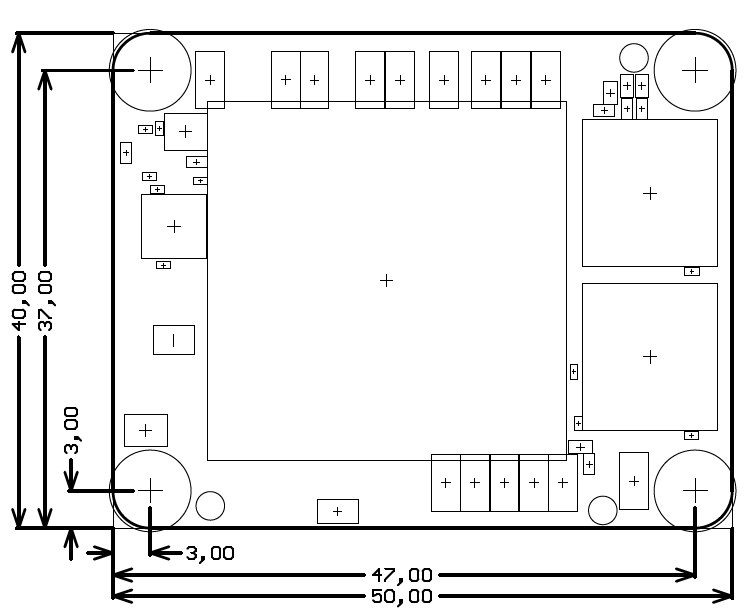
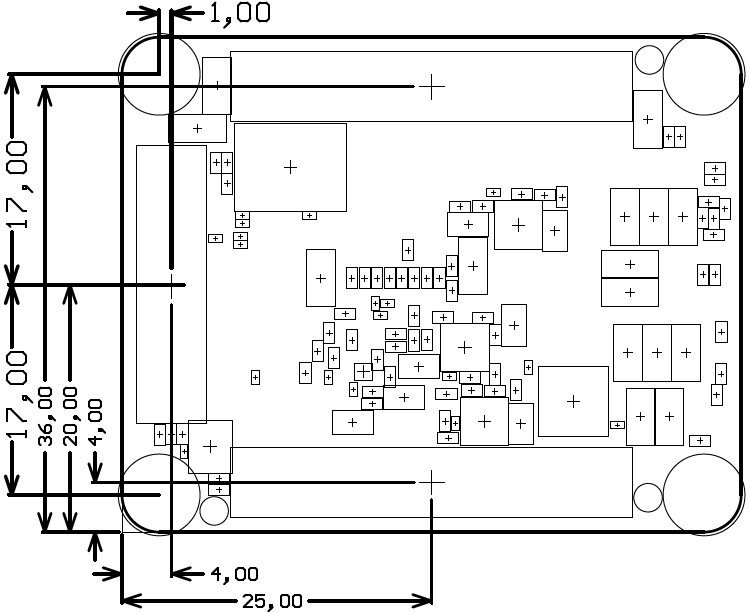
Figure 6: Physical dimensions of the TE0741 module. All dimensions are shown in millimeters.
19 g - Plain module.
8.8 g - Set of nuts and bolts.
| Date | Revision | Notes | PCN | Documentation |
|---|---|---|---|---|
| 2016-10-25 | 03 | 1) Fixed DC-DC connection for parallel operation 2) Samtec Razor Beam connectors updated 3) Serial number (traceability) pad added 4) Changed ferrite beads L1..L4 size 0402 to BKP0603HS121-T 5) Thermal vias added to mounting holes | PCN-20170106 | TE0741-03 |
| 2013-11-06 | 02 |
| TE0741-02 | |
| 01 | First production release |
Hardware revision number is written on the PCB board together with the module model number separated by the dash.


Figure 7: TE0741 PCB revision number.
| Date | Revision | Contributors | Description |
|---|---|---|---|
| |||
| 2018-08-29 | v.64 | John Hartfiel |
|
2017-11-10 | v.63 | John Hartfiel |
|
| 2017-08-28 | v.60 | Jan Kumann |
|
| 2017-07-20 | v.57 | John Hartfiel |
|
| 2017-06-07 | v.55 | Jan Kumann |
|
| 2017-06-02 | v.50 | Jan Kumann |
|
| 2017-01-22 | v.42 | Jan Kumann |
|
| 2017-01-13 | v.38 | Jan Kumann |
|
| 2017-01-12 | v.21 | John Hartfiel |
|
| 2016-12-14 | v.19 | Ali Naseri |
|
| 2013-12-02 | v.1 | Antti Lukats, Jon Bean |
|